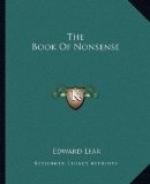In his third book, Mr. Lear takes occasion in an entertaining preface to repudiate the charge of harboring any ulterior motive beyond that of “Nonsense pure and absolute” in any of his verses or pictures, and tells a delightful anecdote illustrative of the “persistently absurd report” that the Earl of Derby was the author of the first book of “Nonsense.” In this volume he reverts once more to the familiar form adopted in his original efforts, and with little falling off. It is to be remarked that the third division is styled “Twenty-Six Nonsense Rhymes and Pictures,” although there is no more rhyme than reason in any of the set. Our favorite illustrations are those of the “Scroobious Snake who always wore a Hat on his Head, for fear he should bite anybody,” and the “Visibly Vicious Vulture who wrote some Verses to a Veal-cutlet in a Volume bound in Vellum.” In the fourth and last of Mr. Lear’s books, we meet not only with familiar words, but personages and places,—old friends like the Jumblies, the Yonghy-Bonghy-Bo, the Quangle Wangle, the hills of the Chankly Bore, and the great Gromboolian plain, as well as new creations, such as the Dong with a luminous Nose, whose story is a sort of nonsense version of the love of Nausicaa for Ulysses, only that the sexes are inverted. In these verses, graceful fancy is so subtly interwoven with nonsense as almost to beguile us into feeling a real interest in Mr. Lear’s absurd creations. So again in the Pelican chorus there are some charming lines:—
“By day we fish, and
at eve we stand
On long bare islands of yellow
sand.
And when the sun sinks slowly
down,
And the great rock-walls grow
dark and brown,
When the purple river rolls
fast and dim,
And the ivory Ibis starlike
skim,
Wing to wing we dance around,”
etc.




